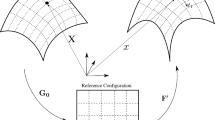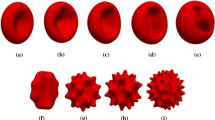Abstract
By using a fully coupled fluid–cell interaction model, we numerically simulate the dynamic process of a red blood cell passing through a slit driven by an incoming flow. The model is achieved by combining a multiscale model of the composite cell membrane with a boundary element fluid dynamics model based on the Stokes flow assumption. Our concentration is on the correlation between the transit time (the time it takes to finish the whole translocation process) and different conditions (flow speed, cell orientation, cell stiffness, cell volume, etc.) that are involved. According to the numerical prediction (with some exceptions), the transit time rises as the cell is stiffened. It is also highly sensitive to volume increase inside the cell. In general, even slightly swollen cells (i.e., the internal volume is increased while the surface area of the cell kept unchanged) travel dramatically slower through the slit. For these cells, there is also an increased chance of blockage.









Similar content being viewed by others
References
An X, Mohandas N (2007) Disorders of red cell membrane. Br J Haematol 41(3):367–375
Buono MJ, Krippes T, Kolkhorst FW, Williams AT, Cabrales P (2016) Increases in core temperature counterbalance effects of haemoconcentration on blood viscosity during prolonged exercise in the heat. Exp Physiol 101(2):332–342
Chien S (1987) Red cell deformability and its relevance to blood flow. Annu Rev Physiol 49:177–192
Cordasco D, Yazdani A, Bagchi P (2014) Comparison of erythrocyte dynamics in shear flow under different stress-free configurations. Phys Fluids 26:041902
Daily B, Elson E, Zahalak G (1984) Determination of the elastic area compressibility modulus of the erythrocyte membrane. Biophy J 45:671–682
Dupire J, Socol M, Viallat A (2012) Full dynamics of a red blood cell in shear flow. PNAS 109:20808–20813
Evans E, Skalak P (1980) Mechanics and thermodynamics of biomembranes. CRC Press, Boca Raton
Evans E, Waugh R, Melnik L (1976) Elastic area compressibility modulus of red cell membrane. Biophys J 16:585–595
Fedosov DA, Caswell B, Karniadakis GE (2011) Wall shear stress-based model for adhesive dynamics of red blood cells in malaria. Biophys J 100:2084–2093
Freund J (2013) The flow of red blood cells through a narrow spleen-like slit. Phys Fluids 25:110807
Kodippili G, Spector J, Sullivan C, Kuupers F, Labotka R, Gallagher P, Ritchie K, Low P (2009) Imaging of the diffusion of single band 3 molecules on normal and mutant erythrocytes. Blood 113:6237–6245
Kor D, Buskirk CV, Gajic O (2009) Red blood cell storage lesion. Bosn J Basic Med Sci 9(sup.1):21–27
Li F, Chan C, Ohl C (2013) Yield strength of human erythrocyte membranes to impulsive stretching. Biophy J 105:872–879
Lim G, Wortis M, Mukhopadhyay R (2002) Stomatocyte-discocyte-echinocyte sequence of the human red blood cell: evidence for the bilayer-couple hypothesis from membrane mechanics. PNAS 99:16766–16769
Lion N, Crettaz D, Rubin O, Tissot J (2010) Stored red blood cells: a changing universe waiting for its map(s). J Proteomics 73(3):374–385
MacDonald I, Ragan D, Schmidt E, Groom A (1987) Kinetics of red blood cell passage through interendothelial slits into venous sinuses in rat spleen, analyzed by in vivo microscopy. Microvasc Res 33:118–134
Maier A, Cooke B, Cowman A, Tilley L (2009) Malaria parasite proteins that remodel the host erythrocyte. Nat Rev Microbiol 7(5):341–354
Mohandas N, Evans EA (1994) Mechanical properties of the red cell membrane in relation to molecular structure and genetic defects. Annu Rev Biophys Biomol Struct 23:787–818
Otter WK, Shkulipa SA (2007) Intermonolayer friction and surface shear viscosity of lipid bilayer membranes. Biophys J 93:423433
Park Y, Diez-Silva M, Popescu G, Lykotrafitis G, Choi W, Feld MS, Suresh S (2008) Refractive index maps and membrane dynamics of human red blood cells parasitized by Plasmodium falciparum. Proc Natl Acad Sci USA 105(37):13730–13735
Peng Z, Zhu Q (2013) Deformation of the erythrocyte cytoskeleton in tank treading motions. Soft Matter 9:7617–7627
Peng Z, Asaro R, Zhu Q (2010) Multiscale simulation of erythrocyte membranes. Phys Rev E 81:031904
Peng Z, Asaro R, Zhu Q (2011) Multiscale modeling of erythrocytes in Stokes flow. J Fluid Mech 686:299–337
Peng Z, Mashayekh A, Zhu Q (2014) Erythrocyte responses in low shear rate flows—effects of non-biconcave stress-free state in cytoskeleton. J Fluid Mech 742:96–118
Peng Z, Salehyar S, Zhu Q (2015) Stability of the tank treading modes of erythrocytes and its dependence on cytoskeleton reference states. J Fluid Mech 771:449–467
Pivkin IV, Peng Z, Karniadakis GE, Buffet PA, Dao M, Suresh S (2016) Biomechanics of red blood cells in human spleen and consequences for physiology and disease. PNAS 113:7804–7809
Pozrikidis C (1992) Boundary integral and singularity methods for linearized viscous flow. Cambridge University Press, Cambridge
Pozrikidis C (1996) Computation of periodic Green’s functions of Stokes flow. J Eng Math 30:79–96
Pozrikidis C (2005a) Axisymmetric motion of a file of red blood cells through capillaries. Phys Fluids 17:031503
Pozrikidis C (2005b) Numerical simulation of cell motion in tube flow. Annu Biomed Eng 33:165–178
Quinn D, Pivkin I, Wong S, Chiam K, Dao M, Karniadakis G, Suresh S (2011) Combined simulation and experimental study of large deformation of red blood cells in microfluidic systems. Annu Biomed Eng 39:1041–1050
Salehyar S, Zhu Q (2016) Deformation and internal stress in a red blood cell as it is driven through a slit by an incoming flow. Soft Matter 12:3156–3164
Satcher RL Jr, Dewey CF Jr (1996) Theoretical estimates of mechanical properties of the endothelial cell cytoskeleton. Biophy J 71:109–118
Sung LA, Vera C (2003) Protofilament and hexagon: a three-dimensional mechanical model for the junctional complex in the rbc membrane skeleton. Ann Biomed Eng 31:1314–1326
Tran-Son-Tay R, Sutera S, Rao P (1984) Determination of red blood cell membrane viscosity from rheoscopic observations of tank-treading motion. Biophys J 46:65–72
Tsubota K, Wada S, Liu H (2014) Elastic behavior of a red blood cell with the membrane’s nonuniform natural state: equilibrium shape motion transition under shear flow and elongation during tank-treading motion. Biomech Model Mechanobiol 13:735746
Weinbaum S, Tarbell J, Damiano E (2007) The structure and function of the endothelial glycocalyx layer. Annu Rev Biomed Eng 9:121–167
Xiao LL, Liu Y, Chen S, Fu BM (2016) Numerical simulation of a single cell passing through a narrow slit. Biomech Model Mechanobiol. doi:10.1007/s10237-016-0789-y
Yalcin O, Ortiz D, Tsai AG, Johnson PC, Cabrales P (2014) Microhemodynamic aberrations created by transfusion of stored blood. Transfusion 54(4):1015–1027
Zhang Y, Huang C, Kim S, Golkaram M, Dixon M, Tilley L, Li J, Zhang S, Suresh S (2015) Multiple stiffening effects of nanoscale knobs on human red blood cells infected with Plasmodium falciparum malaria parasite. Proc Natl Acad Sci USA 112(19):6068–6073
Zhao H, Isfahania A, Olsonc L, Freund J (2010) A spectral boundary integral method for flowing blood cells. J Comput Phys 229:3726–3744
Zhu Q, Asaro R (2008) Spectrin folding versus unfolding reactions and RBC membrane stiffness. Biophys J 94:2529–2545
Zhu Q, Vera C, Asaro R, Sche P, Sung LA (2007) A hybrid model for erythrocyte membrane: a single unit of protein network coupled with lipid bilayer. Biophys J 93:386–400
Acknowledgements
The authors would like to thank Dr. Pedro Cabrales for discussions about the effects of exercise and blood storage on the mechanical properties of red cells.
Author information
Authors and Affiliations
Corresponding author
Ethics declarations
Conflict of interest
The authors declare that they have no conflict of interest.
Rights and permissions
About this article
Cite this article
Salehyar, S., Zhu, Q. Effects of stiffness and volume on the transit time of an erythrocyte through a slit. Biomech Model Mechanobiol 16, 921–931 (2017). https://doi.org/10.1007/s10237-016-0861-7
Received:
Accepted:
Published:
Issue Date:
DOI: https://doi.org/10.1007/s10237-016-0861-7




